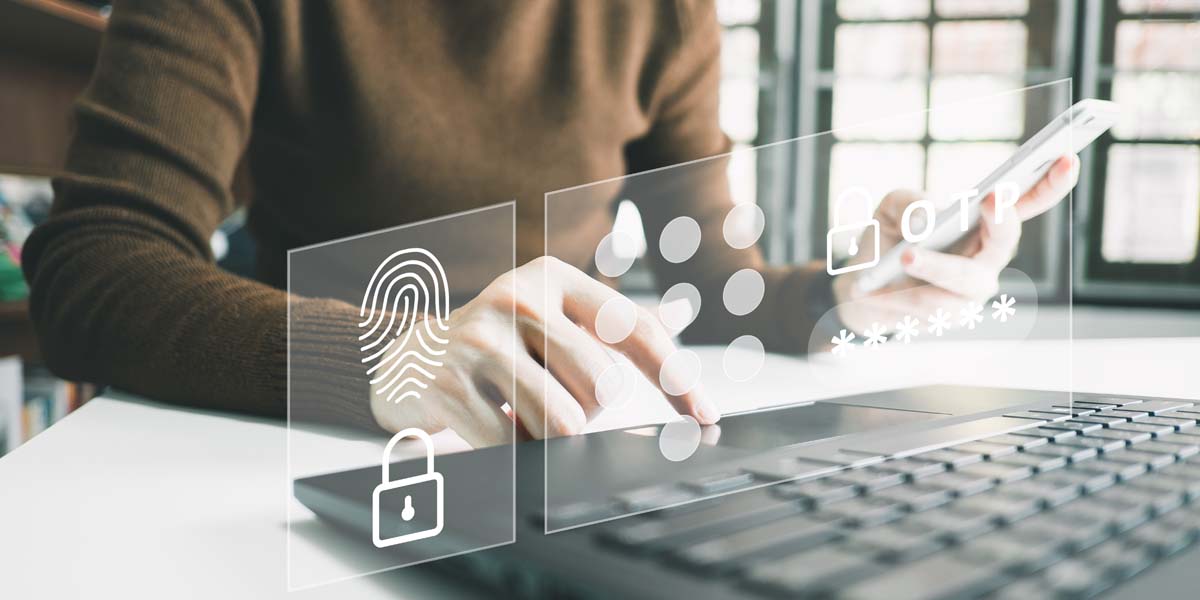Cybercrime is taking an unprecedented toll on businesses like yours. According to Cybersecurity Ventures, the cost of cybercrime is predicted to reach $8 trillion in 2023 and is expected to grow to $10.5 trillion by 2025.
Companies that are lax with cybersecurity are taking a huge risk. According to recent data from the Identity Theft Resource Center, there was a 14 percent increase in data breaches and compromises during the first quarter of 2022, compared to 2021.
Here are the main types of cybersecurity threats in 2023:
- Malware attacks
- Social engineering attacks
- Software supply chain attacks
- Advanced persistent threats (APT)
- Distributed denial of service (DDoS)
- Man-in-the-middle attack (MitM)
- Password attacks
You might be wondering what the best way is to significantly boost your company’s online security. It is multi-factor authentication (MFA).
Watch this video to learn more about the importance of MFA:

What is MFA?
Multi-factor authentication requires users to provide two or more pieces of evidence to gain access to a network, application, or system and can dramatically decrease the likelihood of infiltration. These two pieces of information are categorized into three categories. They are:
- Something you have, such as a physical fob or message sent to your smartphone.
- Something you know, like a PIN or a password.
- Something on your body, such as a fingerprint or facial scan.
Multi-factor authentication and two-factor authentication (2FA) can sometimes be confused and be thought of as the same thing, but they’re not. 2FA refers to using more than one authentication method as opposed to multi-factor authentication, which refers to utilizing two or more authentication methods.
There is also password-less authentication, which is a form of authentication that doesn’t require a password. It can be done by simply using a fingerprint, a physical security key, and other ways that don’t require a password.

Types of Multi-Factor Authentication
There are several different methods used to confirm user identities when it comes to multi-factor authentication. Among the most common authentication methods are the following:
Authenticator Apps
Websites and other online services typically utilize third-party applications to support mobile authentication. These kinds of apps generate one-time-use codes that assist in verifying a user’s identity. Among the most common authenticator applications are Google Authenticator and Microsoft Authenticator.
Physical Security Keys
Security keys appear similar to thumb drives and are used by plugging into a computer’s USB port. They are different from other types of authentications in that these types of keys need to be physically present for a device to be authenticated.
Email and Text Codes
An email or text message is sent to a user and it contains a link that will connect to either a verification page or display a one-time code. That code must be entered before the user can log in to their account.
Biometric Authentication
This specific type of authentication utilizes biometric data to recognize and identify a user based on physical characteristics like fingerprint scans, iris scanning, voice recognition, and facial recognition. One example of biometric authentication is Face ID on Apple devices which uses facial recognition to identify users.

Security Benefits of Multi-Factor Authentication
There are many ways that multi-factor authentication can enhance the cybersecurity of your business. Here are six of the most important advantages that multi-factor authentication gives you when it comes to protecting your company from cybercriminals and strengthening your online security.
1) Adds Next-Level Security
All too often, cybercriminals attempt to infiltrate a company’s system when a user is working remotely. Their objective can become complicated if multi-factor authentication is used with an SSO (Single Sign-On) solution. Multi-factor authentication can help your organization block these users and even report potential threats. Your IT department will be notified right away. They will then take measures to block these users.
2) Adds Extra Security Layers to Your Accounts
Multi-factor authentication gives you the peace of mind of knowing that it offers more security layers than, for instance, 2FA. These numerous security measures ensure that only approved users can gain access to their information. So, even if cybercriminals can access a user’s credentials, they will still be required to use another method to verify identities.
It all comes down to the more authorization methods, the more secure your company’s accounts will be.

3) Secures Remote Working
Cybercriminals often try to intercept and gain access to your company’s system when an employee works remotely. Multi-factor authentication will help you in preventing these threats from happening with adaptive authentication.
Adaptive authentication is a type of authentication that verifies a user’s identity by viewing a variety of information like locations, device type, behavior, and more.
4) Meets Regulatory Compliance
When your company implements multi-factor authentication, it is imperative that you adhere to specific industry standards. It can sometimes be required.
For example, multi-factor authentication assists healthcare providers in complying with the Health Insurance Portability and Accountability Act (HIPPA). HIPPA is intended to protect patients’ sensitive information.
Also, multi-factor authentication has been a requirement by a majority of cyber insurance providers to secure coverage. Businesses that refuse to acquire multi-factor authentication are in jeopardy of paying a higher premium or maybe losing their insurance coverage.
5) Complies with Single Sign-On (SSO) Solutions
Because multi-factor authentication is industry compliant and comes with an SSO solution, you do not have to create multiple complex passwords for different applications. Using a secondary authentication with SSO verifies the consumer’s identity and removes the risk of losing data because of password misplacement.
This saves your company time and strengthens your online security.
6) Scalable for Changing User Bases
Multi-factor authentication readily adapts to your company’s needs. It can be set up for all users, including your employees, customers, and business partners. You can forgo the need for multiple passwords with a single sign-on combined with multi-factor authentication.
This streamlines the user log-in process and significantly improves the user experience. It also decreases the number of calls to your IT department for password assistance.
Is Multi-Factor Authentication Right for Your Business?
Adding multi-factor authentication is the number one action most companies can take to strengthen their online security. A greater number of businesses are taking cybersecurity more seriously as more of them are being targeted by cybercriminals, especially small businesses.
Investing in a multi-factor authentication solution is an effective way to secure your company’s critical data from unauthorized access and protect your valuable resources.
Connect with Adept Networks So We Can Provide Your Business with the Best Online Security Available
At Adept Networks, online security is our number one priority for your business. Our goal at Adept Networks is to provide you with the best network security protection possible, while also keeping your unique needs and budget in mind. Implementing multi-factor authentication is a powerful way to significantly enhance your online security.
If your team is negligent when it comes to security, you run the risk of litigation and/or closing your doors due to a data breach or data loss. Adept Networks is here to help as a leader in online security solutions.

